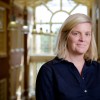This article is more than 5 years old.
Monday, Steve and I drove to the LAUNC-CH Conference at the Friday Center in Chapel Hill for the 2011 Conference. We rode in style in the ZSR van because I had roped Steve into picking up the recently digitized Howlers from the North Carolina Digital Heritage Center after the conference. He is a real trooper.
The Keynote address by Lee Rainie, the Director of the Pew Internet & American Life Project, focused on the use of the internet, cell phones, and the changes in use with the growing popularity of social networking, geolocation apps, and other fast growing internet based “distractions”. Mr. Rainie made some very thought provoking points discussing the shift of people’s social and information accessing behavior from tight nit and smaller groups of people that may be similar in ethnicity, location, and beliefs to a broader audience. With the increase in connectivity through broadband internet, people are not “place bound”, creating more personal autonomy and a “DIY-style” management of personal information.
This idea of changing technology and information seeking behavior strikes a chord specifically (for me) in Special Collections and Archives. As researchers, patrons, and the general public shift their use of technology, special collections and archives struggles to keep up with the changing technology and varying expectations of patrons. Mr. Rainie’s keynote address only solidifies what is already apparent in the Special Collections Department: we need to provide more access through technology. The next question is, how?
Luckily, on the heels of Lee Rainie’s speech, I attended a session that I found particularly exciting and timely. “Putting It to Use: Repurposing Archival Description for Digitization” was presented by Brian Dietz and Jason Ronallo from NCSU. I was blown away by the work they are doing and I could not wait to come back to ZSR and tell my colleagues. They have created an open-source software program called “Library Mead” that takes the archival description and nesting aspects of the finding aid and container lists and automates file names for digital items that are part of each specific collection. Having this connection between digital items and collection name and location is something we have been struggling with on the sixth floor for a while now. Utilizing this automated system would provide consistent and accurate file names for our digital objects. In addition to this, the system can create stub records for Voyager which would allow additional information to be added to the catalog. Needless to say, this presentation left me both excited and full of questions.
“Staying Vital in a Time of Change” is certainly an appropriate tagline for this conference. I enjoyed all of the sessions I attended and appreciate the local librarians for thinking outside of the box. Thanks to Wanda, Lynn, and Katherine for the opportunity!

1 Comment on ‘Rebecca at LAUNC-CH’
I know Brian Dietz from NCPC-he’s a whiz and maybe we could start a discussion with him on using this product. Thanks Rebecca-this is exciting.